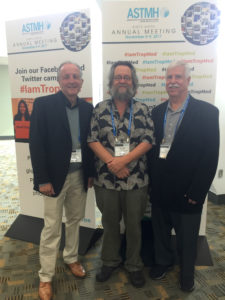Hawai‘i Task Force Meets With Rat Lungworm Disease Experts

(From left to right) Vernon Ansdell, M.D., William L. Gosnell, Ph.D. and Kenton Kramer, Ph.D. are representing Hawaii at the American Society of Tropical Medicine and Hygiene Annual Meeting this week in Baltimore to discuss issues concerning the diagnosis and treatment of rat lungworm disease. Photo Courtesy
The Hawai‘i Department of Health has been working collaboratively with the Governor’s Joint Task Force on Rat Lungworm Disease to provide widespread education about the risks associated with the debilitating disease and how to prevent it, as well as address issues around diagnosis and treatment.
This week, a contingent of task force members are attending the American Society of Tropical Medicine and Hygiene Annual Meeting, which takes place from Nov. 5 to 9, 2017, in Baltimore, MD.
The task force will meet with national and international experts to discuss the controversial concerns around the diagnosis and treatment of rat lungworm disease.
After attending the meeting, their goal is to develop evidence-based clinical practice guidelines, to be used as a critical resource by practicing physicians statewide.
“In addition to the devastating effects this disease can have on its victims, the core issue is that there just isn’t much information on how to best diagnose and treat those who are infected,” said Dr. Kenton Kramer, associate professor with the John A. Burns School of Medicine and chairperson of the Task Force. “We recognize the frustration people feel when repeat medical visits are needed to diagnose symptoms, and that treatment options are slim and not always effective. We plan to take full advantage of the wealth of knowledge available at this meeting and hope the guidelines developed will be a practical and useful tool for Hawai‘i clinicians.”
Task Force members attending the meeting include:
- Kenton Kramer, Ph.D., associate professor, University of Hawai‘i John A. Burns School of Medicine
- William L. Gosnell, Ph.D., assistant professor, University of Hawai‘i John A. Burns School of Medicine
- Vernon Ansdell, M.D., internal medicine specialist and tropical medicine specialist, associate clinical professor, University of Hawai‘i John A. Burns School of Medicine.
There is no cure for rat lungworm disease as of yet. Treatment options are typically supportive by using steroids to reduce inflammation, which causes the symptoms infected people may experience.
The use of anti-parasitic drugs, such as albendazole, are heavily debated because in theory it may worsen a patient’s illness. It remains controversial despite more than 20 years of debate in the medical community.
The most common symptoms of rat lungworm disease include severe headaches and neck stiffness, but symptoms may vary widely among cases. The most serious cases may experience neurological problems, pain, and severe disability. The best way to prevent infection is to avoid eating infected slugs and snails, which may be hidden on unwashed produce.
Thoroughly washing all fruits and vegetables under clean, running water before eating to remove pests, in addition to controlling rat, slug and snail populations, greatly reduces the risk of spreading rat lungworm disease.
More information about rat lungworm disease may be found online.










